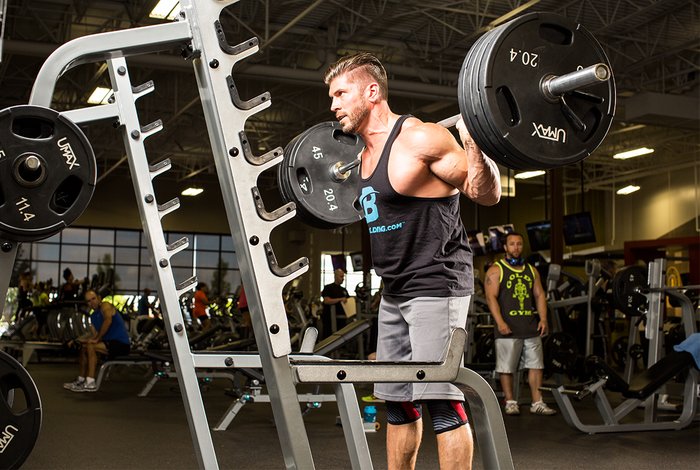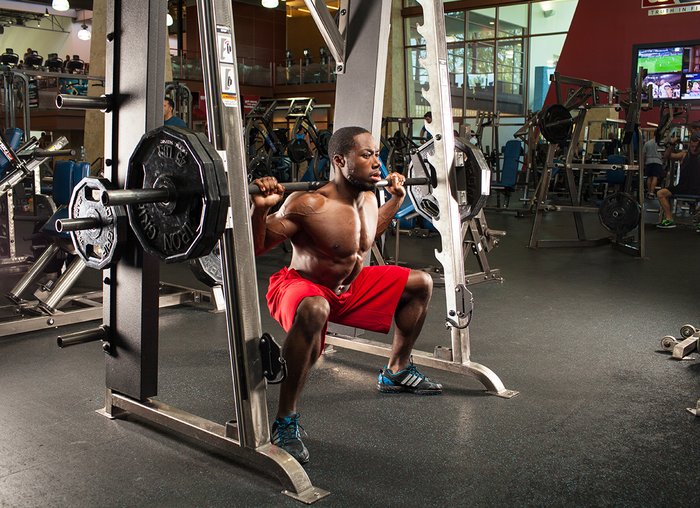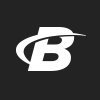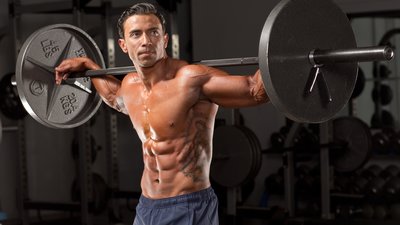Squatting is one of the most productive if not the best exercises out there (it's called the King of Exercises by many). It is one of the most difficult to learn as well. If you are new to this exercise, please take several training sessions practicing with an empty bar or broomstick (you can do some additional work on the leg press if needed). It's very important to get your technique down cold while the weights are still light. Your small errors with small weights will turn into BIG errors with big weights. Much of the bad press the squat has received in the media is a result of improper technique and not the exercise itself. Red flags you may encounter will be pointed out and hopefully how to avoid them.
First Things First
The first thing to discuss is not foot position or width of stance, but proper trunk position. Pretend you are a soldier and the meanest, ugliest sergeant ever just told you "TEN-HUT!" You would automatically straighten up and pull your head and shoulders back. This is the proper position of the spine for the squat. IOW, your head is pulled back; your chest is raised; and you have a slight arch in your lower back. At no time during the squat should you bend over at the low back or look down. Of course you have to bend over at the hip (more on that later). You should not look up either. OK, so you got that down?
Now, the best way to do squats is in a power rack or cage (a large rectangular rack with cross-drilled holes) so you can adjust the pins where if you have to bale, you can set the bar down without any harm. Set the pins to just below the depth you are going. They also serve as a visual cue for depth and if you go down/up crooked. Place the J hooks or posts that hold the bar for you to get under at the level of your nipple or so. Try to unrack it once to see if it's at the right height. The bar should have a knurled area in the middle (if it doesn't, find another bar or another gym) so it will not slide down your back.

Barbell Squat
Many people use towels or padding under the bar. Others (including me) feel this leads to some instability because the weight is "teeter tottering" on a small area on your back. If the bar is hurting you either need to add some trapezius mass, place the bar a little further down your back (it should be just above or below the sharp ridge on your scapula (shoulder blade), buy a Manta Ray, or tolerate it because it's part of the game. The Ray helps to spread the load across the shoulder, but it doesn't fit everyone well.
Now step up to the bar. Place your hands about the same width as a bench press (unless you are doing the shoulder breaker wide-grip variety) and make sure you are even on the bar before unracking. Take a deep breath, step under the bar and unrack it. Most squat injuries (according to Fred Hatfield) occur during the back up. Only take enough steps that you can clear the j-hooks or posts on the descent. Remember the "soldier position" even in the unracking and back up. Place your feet shoulder width or slightly farther apart. Think if you suspended a line from the ceiling it would brush against your medial delt and hit you in the ankle.

Use the "practice" sessions to get a width that fits you. You might say many powerlifters squat with a wide-stance and they are pretty strong as a group. I'll agree wholeheartedly, but I'll also point out that the conventional squat is probably more productive because you are working through a larger ROM. Learn this way and then learn the variations if you like. After you have the width right, turn your feet out at roughly a 45 degree angle. Adjust the width if need be. Now you are ready to squat.
Take a deep breath, contract your abs and descend. It should feel like you are sitting back on a chair behind you; not going straight down. Keep your knees in line with your feet. DO NOT LET YOUR KNEES BOW IN anytime during the lift! I have a Grade 1 knee sprain (MCL) from doing just this. Keep the load light enough so you won't do this and gradually build up. Many people say to try to keep your shin at a 90 degree angle to the ground. This is impossible with the regular stance squat and is only possible by a few using the wide-stance variety. Try to keep your knees from going out past your toes. Alter the width if need be. Most people can and should descend till their thighs are parallel to the ground. This is actually pretty low. A very small majority of people can't and may be better stopping just above parallel.
Don't give up on reaching parallel too quick. Also, to go even close to parallel, you have to bend over at the hip (not the spine, of course). However, you should always be more upright than bent over. Two methods of determining your shin/back position and depth is to either have an attentive and adept person monitor you from the side and/or use a video camera placed to the side and close enough to determine all angles. After you have descended to the bottom position, reverse your direction immediately (don't bounce at the bottom) and drive upwards. Try and pull your back up (hip extension) as hard as possible during the ascent.
Brooks Kubik describes this "as if a giant gorilla had a hold of your ass and your shoulder and was trying to straighten you out." Come back to a standing position, take a breath or two (or many 8^) and descend again. Remember the soldier position between reps as well. Make each rep it's own little lift. IOW, make each one count even on your warm-ups. If you maintain good form in your warm-ups, you'll likely retain it for the work sets.
Belts Or Knee Wraps
Should you wear a belt or knee wraps? The former helps to stabilize the spine by increasing intra-abdominal pressure and the latter is just a way of elevating more weight. Especially if you are getting started with the squat, go without either. Use your abdomen as the brace instead of outside help. The knee wraps serve no use except to the powerlifter who wants a bigger max. They may impede the growth of structures around the knee or even cause some harm if used chronically.
The main reason the power rack gathers dust while there is a line for the angled leg press is because squats HURT! It doesn't matter whether it's the skinny beginner using the "big wheels" on each side for the first time or the bonafide 600+ squatter stepping under an already bending bar. They both feel some pain when doing this exercise. Learn to live with it!
The most productive exercises are the most painful. It's a fact of life. If you squat with proper technique and heavy (for you) poundage, you might grunt, scream, cry, hurl and/or pass out, but you probably won't be injured and you'll make terrific headway towards your goals. Learn to be aggressive and focus your complete attention on the task at hand. Good luck and happy training!

